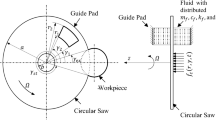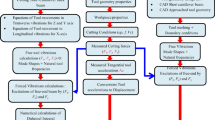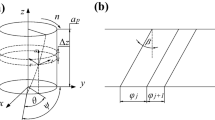Abstract
Reaming is a finishing process used to remove a small amount of material from a predrilled hole. In low speed cutting processes, it is the formation of lobed or multi-cornered holes that is of concern, rather than tool chatter, which occurs at high speed near the natural frequency of the tool. Using a quasi-static model in the characteristic form for the reaming process, a finite element modeling for the low speed reaming process, based on the Euler–Bernoulli beam model, was developed. Cutting and rubbing forces were applied as concentrated and distributed forces on a variable engagement length of the reamer. The variable engagement length is considered to simulate the actual applied forces length as the reamer advances to the workpiece. The time dependant changes in the bending stiffness of the reamer were included in the governing equation of the equilibrium of the reamer, and its stability analysis was performed at different time steps. Using this model, the vibration damping effect of uneven spacing of reamer teeth was investigated. The results demonstrate that uneven spacing of reamer teeth reduces the tool vibration, and therefore leads to a more stable condition. Finally, the optimum configuration of uneven tooth pitch angles for a six-flute reamer, in order to have the highest vibration decay rate during the reaming, was presented.
Similar content being viewed by others
References
Bayly P.V. (1997). Optimal ‘White-Noise’ spacing of reamer blades. In Bains T., MacKenzie D.S. (eds). Proceedings of the 1997 ASM International Non-Ferrous Processing and Technology Conference. ASM International, Materials Park, pp. 419–423
Bayly P.V., Lamar M.T., Calvert S.G. (2002). Low-frequency regenerative vibration and the formation of lobed holes in drilling. Journal of Manufacturing Science and Engineering, 124, 275–285
Bayly P.V., Metzler S.A., Schaut A.J., Young K.A. (2001b). Theory of torsional chatter in twist drills: Model, stability analysis and composition to test. Journal of Manufacturing Science and Engineering, 123, 552–561
Bayly P.V., Young K.A., Calvert S.D., Halley J.E. (2001a). Analysis of tool oscillation and hole roundness error in a Quasi-static model of reaming. Journal of Manufacturing Science and Engineering, 123, 387–396
Bayly P.V., Young K.A., Halley J.E. (1998). Dynamic simulation of reaming: Theory, methods and application to the problem of lobed holes. Dynamics, Acoustics and simulations, ASME publication DE, 98, 245–252
Budak E., Altintas Y. (1993). Prediction of milling coefficients from orthogonal cutting data. ASME Winter Annual Meeting, New Orleans, PED 64, 453–459
Budak, E., & Altintas, Y. (1995). Analytical prediction of stability lobes in milling. CIRP Annals, Jan 1995.
Cheung, Y. K., & Leung, A. Y. (1991). Finite element methods in Dynamics. Kluwer Academic.
Koenigsberger F., Tlusty J. (1970). Structres of machine tools. Oxford, Pergamon Press
Li, C.-J., Ulsoy, A. G., & Endres, W. J. (1998). The effect of the tool rotation on regenerative chatter in line boring. In R. P. S. Han, K. H. Lee, & A. C. J. Luo (Eds.), Dynamics, Acoustics and simulations, ASME publication DE, 98, 235–243.
Logan, D. L. (1999). A first course in the finite element method using algor. Thomson Engineering.
Metzler, S. A., Bayly, P. V., Young, K. A., & Halley, J. E. (1999). Analysis and simulation of radial chatter in drilling and reaming. Proceedings of ASME DETC’99,(CD), Paper No. V1B8059.
Sakuma K., Kiyota H. (1968a). Hole accuracy with carbide-tipped reamers: 1st report. Bulletin of the Japan Society of Precision Engineering, 19, 89–95
Sakuma K., Kiyota H. (1968b). Hole accuracy with carbide-tipped reamers: 2nd report. Bulletin of the Japan Society of Precision Engineering, 20, 103–108
Sridhar R., Hohn R.E., Long G.W. (1968a). A general formulation of the milling processing equation: Contribution for machine tool chatter research 5. ASME Journal of Engineering for Industry, 90, 317–324
Sridhar R., Hohn R.E., Long G.W. (1968b). A stability algorithm for the general milling process. Trans. ASME Journal of Engineering for Industry, 90, 330–334
Tlusty J. (1985). Machine dynamics. In: King R.I. (eds). Handbook of high speed machining technology. New York, Chapman & Hall
Tlusty, J., & Polacek, M. (1963). The stability of machine tools against self-excited vibrations in machining. ASME International Research in Production Engineering, 465–474.
Tobias S.A. (1965). Machine tool vibration. Bishopbriggs UK, Blackie and Son
Towfighian, S. (2006). Finite element modeling of low speed reaming in the application of femoral canal preparation for intramedullary nailing. M.A.Sc. thesis, Ryerson University, Toronto, Canada.
Varterasian, J. H. (1974). Society of manufacturing engineers technical Paper MR74-144, pp. 1–15.
Author information
Authors and Affiliations
Corresponding author
Rights and permissions
About this article
Cite this article
Towfighian, S., Behdinan, K., Papini, M. et al. Finite element modeling of low speed reaming vibrations with reamer geometry modifications. J Intell Manuf 18, 647–661 (2007). https://doi.org/10.1007/s10845-007-0038-4
Received:
Accepted:
Published:
Issue Date:
DOI: https://doi.org/10.1007/s10845-007-0038-4




